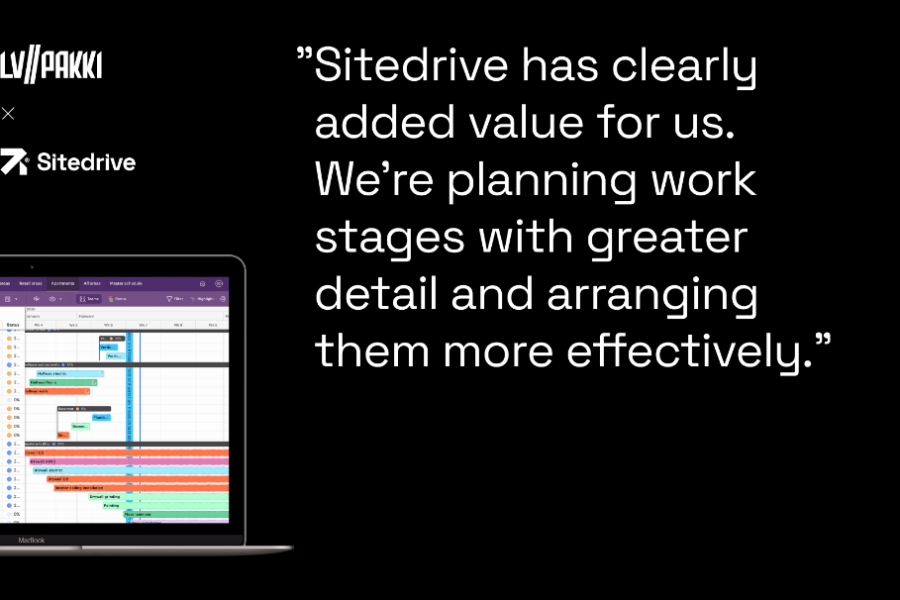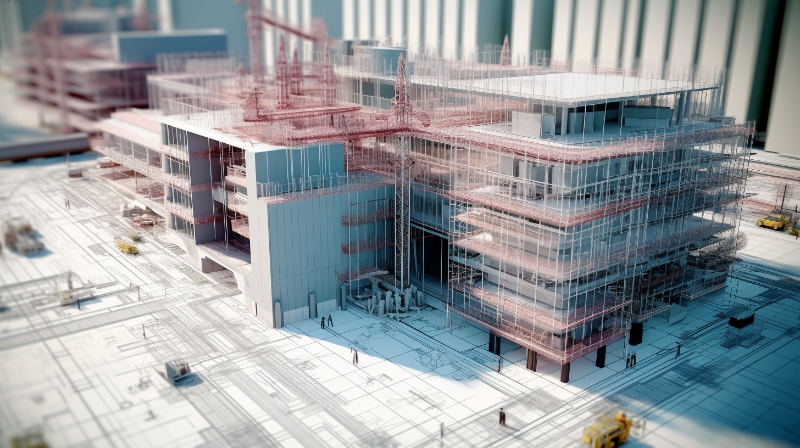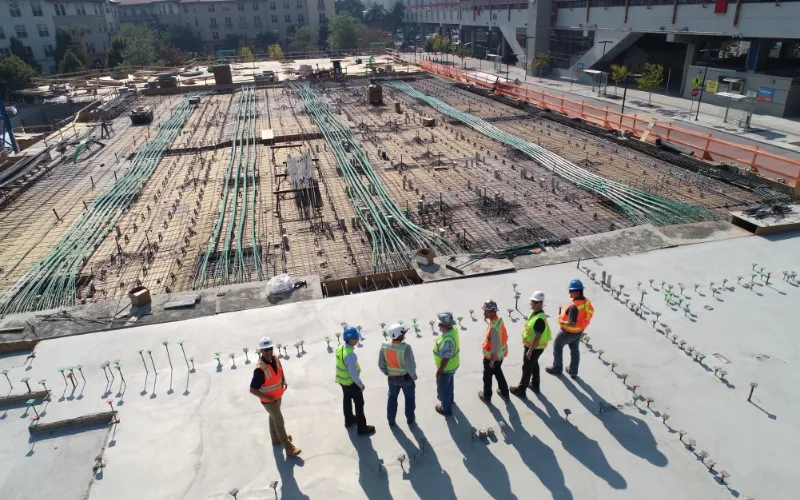Are you interested in using takt time to plan and execute construction sites? Here is our beginner-friendly guide to answer questions like:
- What is takt time?
- What do different takt terms mean?
- What are the basic principles of takt production?
- What is the formula for calculating takt time?
- What are the benefits of takt time for builders, contractors, and the crew?
- How to manage your project with takt production?
But first, let us quickly walk you through why we need better processes in construction.
We all know that the productivity of the building industry is not where it should be. We are wasting astounding amounts of time, money, and resources through general inefficiency. This was measured in practice at a construction site in Finland.
The results were both eerie and familiar. On an average, only 1,6 hours of productive work was achieved per day in each apartment. Various obstacles hindered the progress and also forced the crew to make multiple unnecessary visits to the work areas. In total, there were thousands of visits that lasted less than a minute.It’s safe to say there is no immediate need for anyone to start hammering faster. The most powerful way to improve productivity is to ensure everyone on the site is able to do their work effectively.
If we would be able to go from 1,6 hours to 7 hours of efficient work per day, building times would be shortened by weeks or even months. And that is where takt schedule steps in – Hourly takt is twice as fast as building in the traditional way.
So, let’s dig into it. ⛏️
What is Takt Time?
What does takt mean? Let’s start with the official definition.
In construction, takt is a lean construction method that applies the principles of repeatable industry work to construction projects.
Officially takt time refers to the time dedicated to building. And takt planning, takt production, or takt scheduling refers to the method itself. We prefer the term takt production, as it includes the whole process from planning to execution.
The goal of takt production is to improve the production process of construction and bring more structure to the projects. In practise it means that the requirements of work are fulfilled beforehand, everyone at the site is aware of what is going on, and the site is completed faster.
Successfully executed takt reduces the need to switch from one task to another, ensures the site is managed well, and lessens the waste of time, money, resources, and materials.
In takt production:
- A building is divided into similarly sized takt zones, like floors or apartments.
- The work is split into work packages. Repeating work packages are arranged into work sequences.
- The work sequences are scheduled to move from one floor to another at the same takt time.
- The quality of work is confirmed at the end of each takt time.
>> Read more about the principles of lean construction
Takt terms explained
Takt production has its own set of terms that might be confusing at first. Here you can find the most important ones explained as simply as possible.
Takt time = Takt time can be seen as the pulse of the job site, meaning the time period when the product or part of it needs to be ready. One takt can last for example a week, half a week, a day, half a day, or in most advanced job sites, just an hour. The most important thing is that the takt time is a constant.
Takt zones = Recognisable locations that have similar workloads.
Work packages = Similar work happening on different takt zones that describes one contractor’s work happening during the takt time.
Work sequences / Takt train = The production process that repeats in each zone.
The Basic Pillars of Takt Production
- The work packages always take the same amount of time. This way each takt is repeating the same work, done by the same people. For example, the dividing walls are first built in takt zone 1, then in takt zone 2, and so forth. This way building becomes more foreseeable and manageable.
- Even though the workloads between the work packages differ, they are completed during the same takt time. This means that there are different-sized buffers included in the work packages. Steady rhythm ensures a better construction flow and helps the crews get more done.
- The work is carefully planned beforehand with the key stakeholders of the construction site. Currently, most of the knowledge lives only in the heads of experienced workers. With good software, you can start documenting that expertise alongside the schedule planning. This way you need to use less and less time for scheduling in the future.
- The whole production needs to advance in the same takt. The next work package can be started only after all the work of the previous work package has been finalized.
- The buffer time is no longer located at the end of the project, but at the end of each takt. In the traditional model, we tend to reserve more buffer time than we actually need. But when we pair it with the takt time, we’ll start seeing how much buffer we actually need and can get rid of the extra.
- The schedule will more likely be delayed at the beginning of the project instead of the end. With takt time you’ll learn fast and can optimize your plan already during the job site. If the first zone had too much buffer time, if you faced some surprises or made some mistakes, you know to avoid these on the next takt zones. This means that the flow of construction improves towards the end of the project.
- Communications and transparency is at the core of it. Everyones effort affects the end result and if you are able to stay on takt time or not. That is why it is important that everyone has the access to the schedule and its progress. They also need to understand – and agree to – the plan.
>> Download practical handbook for executing takt
Takt Time Formula
The throughput time of one takt time is calculated with the following formula: the number of takt zones + the number of work packages on one area – 1.
The formula is based on the fact that in each takt your crew opens a new zone.
For example:
An apartment building project, where one takt zone is one floor and we are following weekly takt time. Two houses, 5 floors per building (= 10 floors) and a takt sequence includes 12 work packages. So one floor is finalized in 12 weeks.
10 + 12 – 1 = 21 weeks.
The easiest way to make the process faster is to shorten the takt time. This means that we need to change the end result of the calculations to weeks so its comparable with the original.
If we would keep the amount of work exactly the same, but would switch to a half-a-week takt time, then the end result would need to be divided by two (otherwise we would be calculating half-weeks). In this case the throughput time would be:
10 + 24 – 1 / 2 = 16,5 weeks.
While shortening the takt time it’s good to note that if we split the work from one week to two half-a-weeks, we need two crews to do the work – first crew moves forward to the next zone after the first half when the other half of the work is started on the first zone.
The Benefits of Takt Scheduling
The most important benefits are clear: more systematic process means that building is faster, cheaper, and better quality. On top of that different stakeholders get different types of benefits to their own work.
For builders
- Shorten throughput time up to 70%. When everyone knows what they need to do, their time is used for productive work, and tasks get done correctly on the first try. This leads to a better quality that brings more savings.
- The throughput time of a job site is no longer attached purely to the experience of the planners. Once the knowledge needed for planning is documented and standardized, it doesn’t exist just in the heads of experienced contractors, site managers, and foremen. This way their retirement doesn’t stop the building – new workers coming in learn faster how to plan and execute the sites successfully.
- Get rid of unnecessary buffers. With traditional building you need to add plenty of extra time to the schedule to ensure errors or obstacles don’t break it. When you don’t have data that tells the planner how much different work phases actually take, they don’t know how big of a buffer is needed. That is why we tend to add bigger buffers, just in case. For example if we estimate a job takes two days, we reserve a full week for it. In takt production, we learn more about the actual time needed and can start shortening the buffers in a controlled way.
For general and subcontractors
- Get rid of idle time. At its current shape, building includes a lot of waiting around: the schedule plan might be inaccurate, materials are missing, there are no workers available after all, the previous work phase is delayed, and so on. Takt production ensures that we learn from different work phases, areable to create realistic plans that hold, and our workers can get to work as expected.
- Circle capital faster. As takt production helps you build faster, it also means you can move faster to a new project. So in practise, you get more done within the same timeframe and the same crew.
- Share knowledge of more experienced workers forward. Takt production is an easier way to manage a project and it naturally enhances learning. It means that the average performers get to learn and optimize their ways of doing.
You no longer need to sort everything out at the end. Problems get brought up immediately and solved throughout the project. When an obstacle or an error is noticed early on, it won’t get repeated in the following zones.
For Site Management
- Get better visibility to work and better conditions for good management. When the whole production proceeds at the same pace and its progress is tracked continuously, it’s easier to predict and manage the work. Everyone has a clear overview.
- Bring mistakes and obstacles quickly visible and ensure the work flows. In takt production issues are noticed faster than in traditional production. They also need to solved quickly so that the takt time isn’t disturbed. You might for example notice that the deliveries are constantly late. In traditional construction, these type of grievances often don’t get brought up.
- Nothing is dependent on the workers’ or site managements’ memory. Typically in construction when work is not executed as planned, the crew needs to remember to finalize it later. In takt production your software will take care of reminding you.
For the workers
- Solve issues instantly. When quality is checked on time, mistakes are found as soon as they happen and they won’t become problems that delay the schedule. When the mistakes and obstacles are solved immediately, you don’t have to do as much repair work later and you are able to hand-over error-free zones.
- Achieve more with less hardship. Takt production is not about working harder – vice versa. Well-planned takt schedule means that the workers have more time to focus on the actual work. In an ideal situation you’ll achieve more with less effort and get things right at once.
- The expertise and knowledge gets the respect it deserves. Most often the conflicts at the sites happen because the workers are not listened to in the right places. Takt production is based on good planning and reporting obstacles and changes as soon as they are encountered. Here the expertise of the crew is the key to success.
Take it into practice – Download a handbook to takt production
Are you ready to move from theory to practice? Our takt experts created a handbook with seven, clear steps that help you get started and succeed in takt production.





